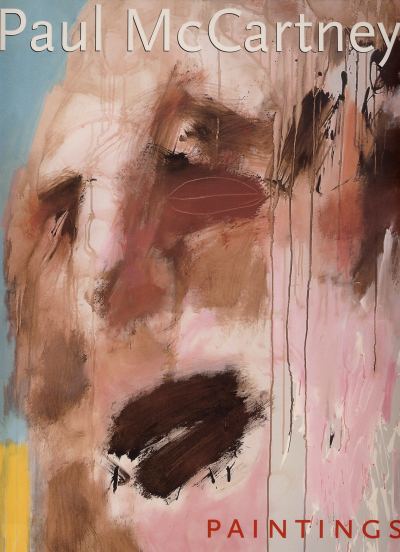| In April 1999 he exhibited the work for the first time in Siegen,
Germany, where it met with critical acclaim, which led to his decision to share the work through the
publication of this volume.
Full of life and intense color, these paintings reveal
McCartney's tremendous positive spirit as well as a visual sophistication and bold handling influenced by
his friendship with Willem de Kooning. He carves, scratches, and sculpts the paint, creating complex and
layered works. Faces abound in the paintings, from the many lovely abstract portraits of Linda McCartney to
irreverent, affectionate portraits of the Queen of England. Humor plays against more somber imagery
— masks and Celtic motifs — while his landscapes radiate a sense of place.
Beautifully designed and produced, the portfolio of paintings is accompanied by candid photographs by
Linda McCartney other husband in the studio. A collection of texts by contemporary critics and curators
place the paintings within context, while a long and insightful interview allows McCartney's own voice to
be heard. Frequent points of crossover between his music and visual explorations will intrigue those
interested in the artistic process. Rarely is one able to find an artist working with such confidence and skill in
such diverse media. All followers of McCartney's will be delighted to see these exuberant works unveiled
and to experience this unexpected and accomplished expression of his creativity.
"
— from the back jacket.
|
|
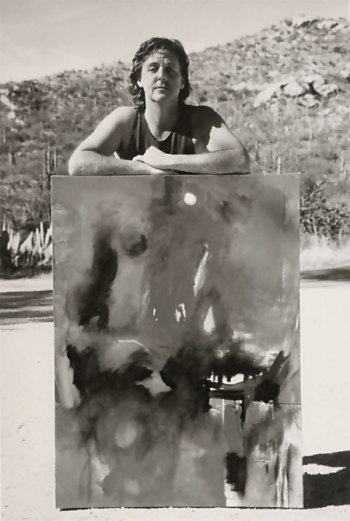 |
|
|
Arizona, 91, with
"Red Abstract White Moon" |
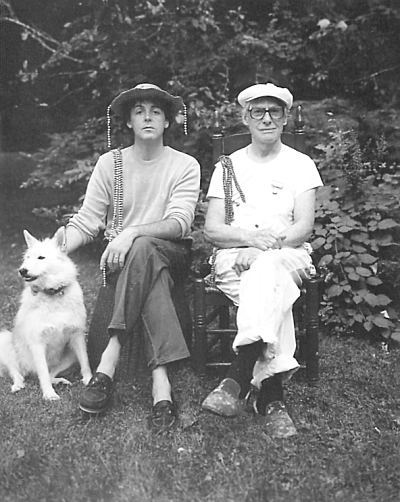
|
|
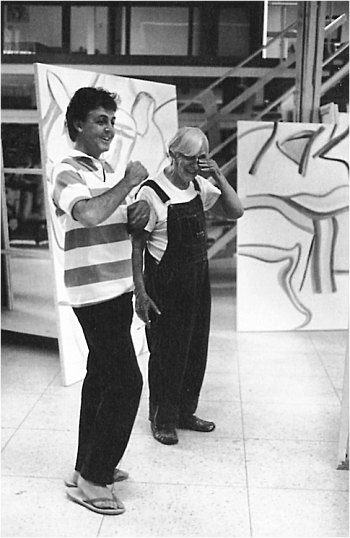 |
| Paul
and Willem de Kooning in 1983 (left) and in 1984 (right).
De Kooning was a family friend and Paul and Linda would always
visit him when they were on Long Island. It was probably
watching de Kooning in action that inspired Paul to do his first
canvases. |
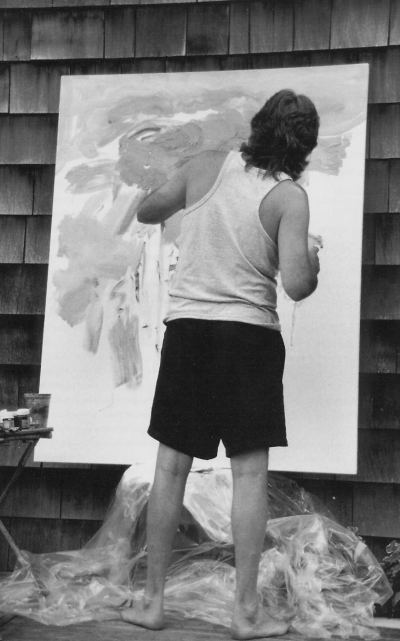 |
|
Essays
& Interview
Paul
McCartney's work is analyzed through a series of essays and
through an interview in which Paul comments on each of his
83 paintings that are exhibited in this book.
Contents
Foreword:
Paul McCartney And The Courage To Get Lost
by
Brian Clarke
Paul McCartney In Context
by
Julian Theuherz
Exposure And Influences In
The Paintings Of Paul McCartney
by
Barry Miles
From Line To Color - From
Gesture To Picture
by
Wolfgang Suttner
Interview: "I Don't
Know - It Looks Like A Couch"
Wolfgang
Suttner speaks with Paul McCartney
Paul McCartney : Reverses
And Other Advances
by
Christoph Tannert
|
|
Long Island
painting, East Hampton, 1990 |
|
|
| Brian
Clarke
Born in 1953, Brian Clarke is a painter and creator of large -
scale colored glass works for architectural projects. Time
magazine has said about him that he "collaborates with some
of the most internationally recognized architects as one of the
world's leading glass artists." He lives and works in
London, New York, and Munich.
Barry
Miles
Born in 1943, Barry Miles is a freelance writer living in
England and France. He is cofounder and editor of the
International Times, an underground British magazine. Supported
by McCartney, he created the Indica Bookshop and Gallery in
London, a center for artistic and avant-garde literature. Later
he led Zapple, the experimental literary label from Apple
Records. Miles is author of the McCartney biography Many Years
from Now and works about Allen Ginsburg and William S.
Burroughs.
Christoph
Tannert
Born in 1955 in Leipzig, Christoph Tannert studied art history
and archaeology at the Humboldt University in Berlin. An art
critic and exhibition curator, he lives in Berlin and writes
regularly for the newspaper Berliner
Zeitung. Since 1991 he has been project leader
for the Bethany artists' house in Berlin.
Wolfgang
Suttner
Born in 1951, Wolfgang Suttner, head of the cultural department
of the county council district of Siegen - Wittgenstein,
Germany, studied art, psychology, and German philology and has
been organizing exhibitions
and art shows for twenty years. He also
founded the Siegen Art Society, is a board member of the
Association of German Art Societies, and has been publishing and
lecturing for the past twenty years on twentieth-century art and
artists.
Wolfgang
Suttner collaborated with Paul McCartney on cataloging and
documenting the latter's artistic oeuvre and directed the
world's first exhibition of McCartney's paintings in the Lyz Art
Forum, Siegen, Germany. |
|
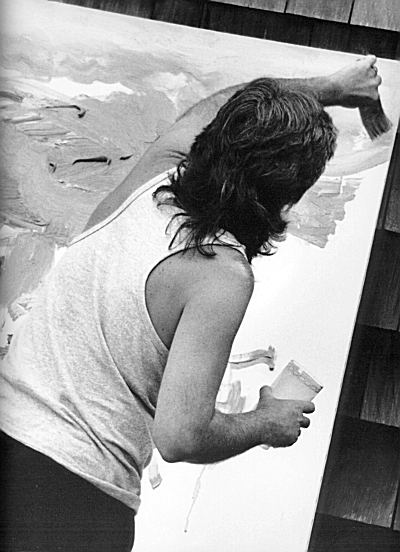
Long Island
brushstroke, East Hampton, 1990
Julian
Treuherz
Julian Treuherz is Keeper of Art Galleries for the National
Museums & Galleries on Merseyside, responsible for the Walker
Art Gallery, Sudley House, and the Lady Lever Art Gallery. He was
previously Keeper of Fine Art at Manchester City Art Gallery. He
is the author of numerous books and articles, with a concentration
on aspects of nineteenth - century British art.
|
|
|
|
|
Paul
McCartney's Paintings
There
are 83 paintings pictured in this book. Here follow some excerpts of
these paintings with the commentaries made by Paul about each of them in
his interview with Wolfgang
Suttner.
|
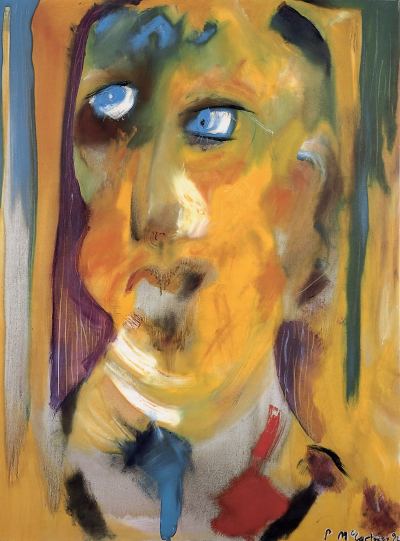
Father
Figure, 1992.
|
|
Wolfgang Suttner:
How important was drawing for you before you started painting?
Paul McCartney: I used to draw a lot, not
necessarily from life but from imagination. And all my days through school I could always draw
quite well. I used to do drawings of women for classmates, but we shouldn't talk about that — I
was the guy who could draw gorgeous naked women, you see, so for young boys this was a
good attraction, and they used to ask me to draw for them. But I have always enjoyed drawing,
often cartoon faces. I like the line, not necessarily the content. I like quick lines, very spontaneous
lines. I like the circle, a couple of eyes, a mouth, and just characters in the faces, so I have done
that quite a bit.
Wolfgang Suttner: Do you now do drawings as a preparing process
for your painting?
Paul McCartney: No, I don't normally; most of the story
happens on the canvas while I am painting. It has to do with what the paint does, so sometimes I
prepare a shape and a rough composition with some lines or with some drawing if I know I want
a definite face or something like that, or I put that on with charcoal or a pencil. But then I used
to find that the charcoal would pick up in the colors and it would make the yellow muddy, so I
started to look for a little process to stop the charcoal moving, and I got interested in
turpentine on it, which takes most of the line away. You wipe it away, the turpentine, but it does some
interesting things and it stops it blending into the colors, so, yes, I do most of the drawing on
the canvas. |
|
|
|
|
"
Unspoken Words "
Wolfgang Suttner:
This is 100 percent
composition—it isn't in every picture.
Paul McCartney:
As you can see, it is very spontaneous and I
didn't really have any preconceived ideas when I started it, but I started with blue behind it and
then I drew some faces on top of that and then just worked on them, just the three faces, and
turned it round a lot when I was working. I turned it lots of ways, upside down often.
Wolfgang Suttner:
You turned the canvas upside down?
Paul McCartney:
Yes, I turned it on its side and
upside down, just to get a look at the composition, to see if it
worked. A lot of the drawing, these blue marks, were done from the upside-down position, and
then in the end I decided it seemed like a woman. It had a kind of grille across it, stopping
it from talking, so it was something to do with forbidden speech. And this guy definitely has a
cross, the face on the right: his mouth seemed to pick up the same theme,
something forbidden. And then this face on the left has got an S
mouth, which is a similar thing, so that became the theme.
|
|
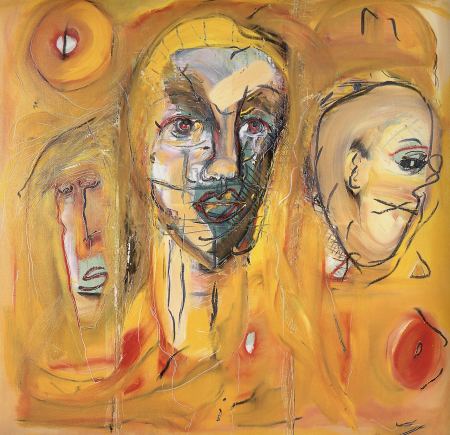
Unspoken Words,
1994.
|
|
|
|
|
|
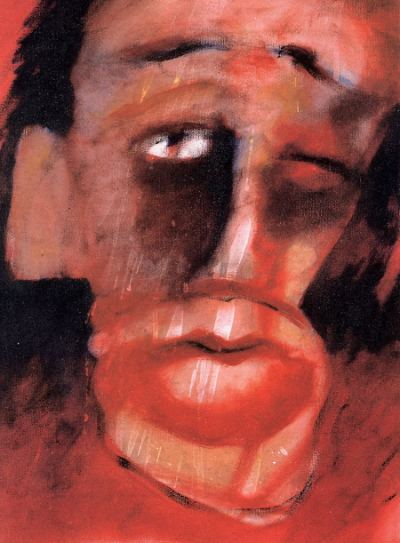
Boxer
Lips, 1990.
|
|
"
Boxer Lips "
Wolfgang Suttner: I like this. It has an absolute richness in red
colors, bright and earthy colors, and those colors give us
certain meaning.
Paul McCartney: What kind of meaning do you think—hot,
sensual, violent?
Wolfgang Suttner:Mystic...
Paul McCartney: The shape of the head is a bit improbable... and again you have the two sorts of eyes. It
wouldn't have been as interesting to me to just have the one eye, or both eyes closed, or both
eyes open. He looks like a boxer possibly after
losing a fight; there is a bit of a battering in that left eye, isn't there? So he is a sort of hero figure,
a warrior figure, like comic-book heroes. I could almost imagine, like Marion
Brando. But I like
these white streaks behind it, like highlights, like lighting on him.
Wolfgang Suttner: Do you remember when you did this picture?
Paul McCartney: No. What I will do with all of these things is I
will try and guess; I can often figure it out. The smaller canvases tend to be a bit earlier because
probably at this time I wouldn't have a big canvas, just do lots of little ones, but then I felt
more comfortable with the bigger canvases.
|
|
Wolfgang Suttner:
He is really perfect.
Paul McCartney: He is really nice. There is something of me
in this, I don't know why, I don't know how to describe it, but a lot of these ideas you can see
the germs of back in my schoolbooks, old schoolbooks I have: little scrawlings, rude ladies,
naked girls, things I was awakening to, and the thrill was being able to conjure them up like an
illusionist. I like the word primitive because a lot of what I do is primitive. Because when I
started out in music, I never took lessons but I learned in a primitive way to make music. I
learned the piano, the guitar in a primitive way.
So when I do things like sail a boat, again it reminds me. I imagine myself like the first man
who had a boat and put a sail up, and the same wind that blows me is the same one that blew
him. I like that ancient connection. It is like your
heritage going right back. And in the same way in painting—the rock painters, cave artists, I love
their work. |
|
|
|
"
Yellow Linda With Piano "
Paul
McCartney:
A couple of people who have looked at my
book singled this one out, a couple of women
who said that is the picture they would like, and I
am not sure why but I like it. This is Linda relax-
ing in my room at home where I have the piano,
and she is sitting on the couch and she was in
yellow. So I made everything yellow. The piano
isn't really yellow, but I just thought it would be
nice. Her hair was yellow, her blouse was yellow,
so I made them all yellow. So it became a very
yellow picture. It didn't need brown or any of
their real colors. This is interesting because this
little stool here, this little piece here, was Rene
Magritte's. That was in a sale of the contents of
his studio, and in this little thing here are his
charcoals and his drawing pens and pencils
exactly as he left them, including his spectacles.
Maybe it was the atmosphere they liked. It's very
peaceful. I enjoyed making it. It is a very typical
pose of Linda's: the legs — this foot is slightly
strange, but I like it — this shoe.
|
|
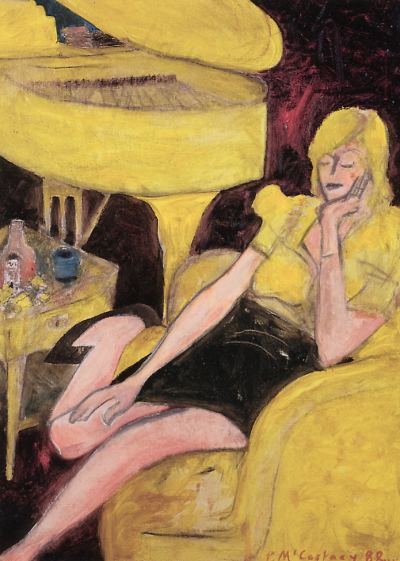
Yellow
Linda With Piano,
1988.
|
|
|
|
|
|
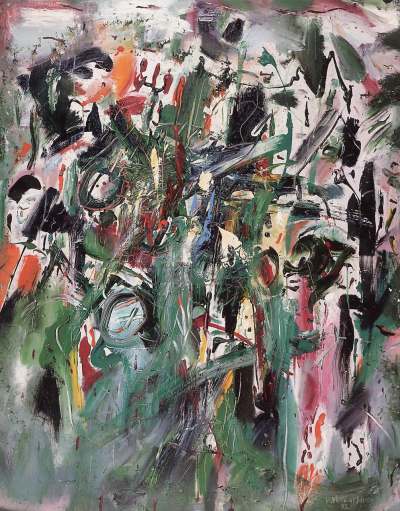
Unfinished
Symphony,
1993.
|
|
"
Unfinished Symphony "
Paul
McCartney: This relates to the couple of other pictures
where I use musical things. There is one called C minor and one called Key
of F, and it was an idea I had to take something I knew very well in
music, a chord, and try and paint the feeling it gave me. So C minor might be a rather lonely-
looking picture because it can be a bit of a sad chord. This came on from those ideas, but this
was then to try and paint a whole symphony. The whole thing rather than one chord; a musical
explosion; an orchestra playing something.
Abstract rather than specific. So for that I just applied a lot of paint and smudged it around and
had a lot of fun with it.
Wolfgang Suttner: This picture has so many different greens and
different structure. It is like you had a lot of chaotic
things and then you have parts that are calm, like a little concept.
Paul McCartney: Well, you know, one of my big inspirations is
nature. I love nature and I love what it does. If you go down on the seashore and watch the
water, see what it does to the sand, it bubbles up and goes back — what you could call
chaos. And yet it's so beautiful, it leaves beautiful marks on the sand. I kind of trust to that, and that is a large part of painting abstracts —to try and
think of myself as nature itself, without a mind, a sophisticated mind that knows how to play a
piano or drive a car... |
|
It is very spontaneous, I don't think there
was a lot of thinking about that. But, you know, my composition generally is spontaneous. Some
people I talk to will ask, "Do you do sketches beforehand?" And I will say, "No, it is
alla prima." You know, I just love to play around with the paint and let the paint show me the way, and
I sense they are not as impressed if they think I did it spontaneously. So I had thought once or
twice of making sketches after I had done the painting. Do little sketches, show shapes, rub
them out and change them, and say, "Oh yes, these are preparatory sketches." |
|
|
|
List
Of Paul McCartney's Paintings
Pintos
in the sky with desert poppy
1991 Acrylic on canvas 152x120.5 cm
Home territory
1990 Acrylic on canvas 101.5x86.5 cm
Mr. Magritte's ruler
1995 Oil on canvas 121.5x121.5 cm
Reclining woman
1987 Acrylic on paper 30x25 cm
Pigtail
1988 Acrylic on paper 30x25 cm
Red eye
1988 Acrylic on paper 30x25 cm
A handbag?
1988 Acrylic on paper 30x25 cm
Is this Bernard Miles?
1988 Acrylicon paper 61x46 cm
Blue face
1988 Acrylic on paper 61x46 cm
White dream
1990 Oil on canvas 101.5x127 cm
Father figure
1992 Acrylic on canvas 121.5x91.5 cm
Big mountain face
1991 Acrylic on canvas 152.5x120.5 cm
Red abstract white moon
1991 Acrylic on canvas 121.5x90.5 cm
Mountain landscrape
1991 Acrylic on canvas 60.5x50.5 cm
Is this a self-portrait?
1988 Oil on canvas 35.5x28 cm
Andy in the garden
1990 Oil on canvas 60.5x90.5 cm
Sea god
1990 Oil on canvas 76x61 cm
Twin freaks
1990 Oil on canvas 121.5x121.5 cm
Yellow bow tie
1989 Oil on canvas 56x40.5 cm
Scratch man
1989 Oil on canvas 51x40.5 cm
Shock head
1989 Oil on canvas 46x35.5 cm
Red yellow face
1989 Oil on canvas 56x40.5 cm
Black scratch I
1994 Oil on canvas 121.5x121.5 cm
Black scratch II
1994 Oil on canvas 151x121 cm
Black scratch III
1994 Oil on canvas 151.5x121 cm
Tara's plastic skirt
1992 Acrylic on canvas 121.5x186 cm
Unfinished symphony
1993 Oil on canvas 151.5x120.5 cm
Yellow Linda with piano
1988 Oil on canvas 56x41 cm |
Large
yellow face
1990 Oil on canvas 121.5x121.5 cm
Chinaman
1990 Oil on canvas 121.5x75.3 cm
Oak
apple twenties man
1988 Acrylic on canvas 35x45 cm
Prehistoric antelope
1989 Acrylic on canvas 61x50.5 cm
Egypt station
1988 Acrylic on canvas 40.5x51 cm
Linda yellow red cross
1991 Oil on canvas 127x101.6 cm
Standing Stone story
1994 Oil on canvas 121.5x121.5 cm
Chief rug
1994 Oil on canvas 121.5x121.5 cm
Celtic eloquence
1994 Oil on canvas 121.5x121.5 cm
Ancient connections
1994 Oil on canvas 121.5x121.5 cm
White Celts
1994 Oil on canvas 121.5x121.5 cm
Celts
1994 Oil on canvas 121.5x121.5 cm
Celtic
fertility
1994 Oil on canvas 121.5x121.5 cm
Yellow Celt
1994 Oil on canvas 121.5x121.5 cm
Black singer
1991 Acrylic on canvas 152.5x120.5 cm
Upturned critic framed
1988 Oil on canvas 61x45.5 cm
Bowie spewing
1990 Oil on canvas 50.5x41 cm
The Queen after her first cigarette
1991 Acrylic on canvas 56x46.5 cm
The Queen getting a joke
1991 Acrylic on canvas 51x40.7 cm
A greener Queen
1991 Acrylic on canvas 56x45.5 cm
Patti Boyd
1989 Acrylic on canvas 91x70.5 cm
Mr. Kipps
1988 Oil on canvas 61x64 cm
Man o' the sea
1988 Acrylic on canvas 76x61 cm
Elvish me
1989 Oil on canvas 91.5X 91.5 cm
Beach boy
1988 Acrylic on canvas 76x61 cm
Red triangle sand
1992 Acrylic on canvas 101.5x101.5 cm
Beach towels
1990 Acrylic on canvas 101.5x101.5 cm
|
Shark
on Georgica
1993 Acrylic on canvas 91.5x92 cm
Unspoken words
1994 Oil on canvas 121.5x121.5 cm
Dark faces
1991 Oil on canvas 121.5x121.5 cm
Robot and star
1995 Oil on canvas 121.5x121.5 cm
Abstract
coloured twenties man
1989 Oil on canvas 121.5x121.5 cm
Blue mask
1989 Acrylicon canvas 61x50.5 cm
White cross face
1990 Oil on canvas 121.5x61 cm
John's room
1990 Oil on canvas 121.5x121.5 cm
Green jacket with cross on shoulder
1989 Oil on canvas 81.5x81.5 cm
Bald head
1990 Oil on canvas 121.5x121.5 cm
Insect face
1989 Oil on canvas 61x45.5
Green head
1988 Acrylic on canvas 101.5x76 cm
Green kiss
1988 Acrylic on canvas 61x49.5 cm
Oast kiss
1988 Acrylic on canvas 61x51 cm
The kiss
1988 Acrylic on canvas 61x49.5 cm
Blue kiss
1988 Oil on canvas 61x49.5 cm
Grey head vision
1992 Acrylic on canvas 60.5x60.5 cm
Housepaint clown
1992 Oil on canvas 91.5x71 cm
Blue tooth
1991 Oil on canvas 121.5x121.5 cm
Three blue faces in red sky
1990 Oil on canvas 91x91 cm
Angry red face
1989 Oil on canvas 56x40.5 cm
Skull face
1989 Oil on canvas 56x40.5 cm
Scared red head
1990 Oil on canvas 76.2x60.9
Half red fog face
1990 Oil on canvas 51x46 cm
Boxer lips
1990 Oil on canvas 40x30 cm
Brains on fire
1994 Oil on canvas 121.5x121.5 cm
C minor
1993 Oil on canvas 122x122 cm
Key of F
1993 Oil on canvas 152x122 cm |
|
|
|
|
